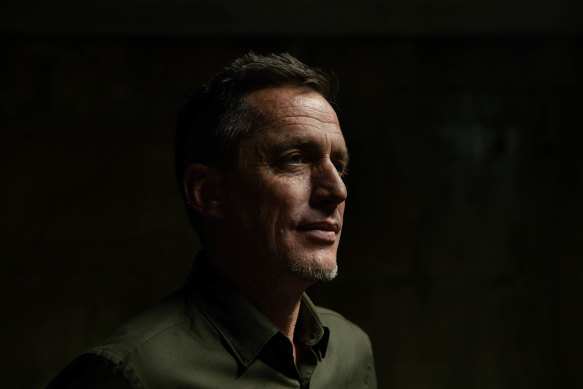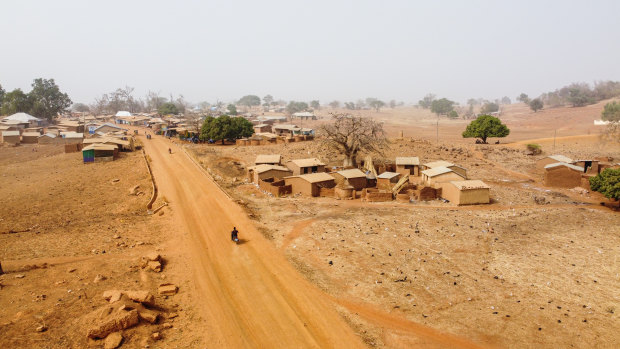This was published 2 years ago
Behind the scenes: Uncovering the Blood Gold investigation
By Eryk Bagshaw
WARNING: This story contains images of the deceased.
Singapore: I was just about to head overseas as North Asia correspondent when an email popped into my inbox. It was early 2021 and Andrew Head, a mining manager from Sydney’s north, wanted to get something off his chest.

Former mining project manager Andrew Head had to consider whether he was prepared to talk publicly about what he saw.Credit: Janie Barrett
“It involves Chinese illegal mining, through government corruption to murder and a lot more,” he said. “I was thinking recently it should be told. Not sure if it’s right for you but thought I would put it out there … feel free to call if of interest to you.”
Head’s email was like many tips we get as journalists. Sometimes they lead nowhere. But sometimes they lead us down a rabbit hole of information, scandal and intrigue.
I emailed Head, suggesting we meet up in person at a cafe in Canberra. It put me on a path that more than a year later would produce Blood Gold, the series that The Age and The Sydney Morning Herald launched on Thursday.
Head and I met for the first time at Mocan and Green Grout in January 2021. It’s an upmarket cafe in the national capital’s trendy Acton area, full of exposed copper, wooden panels, avocado and chèvre. It was a sharp contrast from his former life in remote Ghana, where he worked for the Australian company, Cassius, in a landscape he described as Tatooine – a reference to the dystopian Star Wars desert planet.
Over coffee, Head told me he had witnessed the deaths of more than a dozen miners in Ghana in January 2019. He was still traumatised by the event. The 48-year-old father of three fidgeted as he told me he had pulled miners’ bodies out of the ground. He said he was still grappling with what he had seen – teenage boys frothing at the mouth as they gasped for air.
“It wasn’t a mining accident, it was mass murder,” he said.
Head claimed the miners had been gassed by the Chinese state-linked mining operation, Shaanxi.
Then he said it was also digging hundreds of metres underneath the Australian mining concession to steal millions of dollars in gold.
I was stunned. The story had so many layers – deaths, theft and competition between Australian and Chinese companies – but it needed to be unpacked and stacked up.
I told Head this would take time. He said he needed to think about whether he would go on the record.
Over the next year, local Ghanaian journalist Edward Adeti and I spoke to dozens of other witnesses, Cassius employees, victims’ families and village leaders who backed up Head’s story. Adeti did so – often at great personal risk – facing threats from Shaanxi and political and business leaders in Ghana.
Many of those we spoke to had photos and videos as evidence of what they said was a multimillion-dollar theft that ended in the deaths of scores of miners. Shaanxi has denied the allegations of theft and murder.
By the beginning of 2022, I laid out the information we had gathered to Head. He said he was prepared to go on the record. He brought his rottweiler, Bronsure, with him for support to our studios in North Sydney. Bronsure panted faithfully at his feet as Head recounted what he had told me in that cafe a year earlier.
The end result is what you see today – an in-depth visual story that dives into the Shaanxi and Cassius mines, edited by Nick Ralston and Lia Timson, with photographs by Francis Kokoroko all combined into an interactive report designed by Matthew Absalom-Wong, Matt Malishev and Richard Lama.

The town of Gban, Talensi, where the Shaanxi mine is located.Credit: Francis Kokoroko
The story will now travel to the London International Court of Arbitration where Cassius is suing the Ghanaian government for $395 million in losses from its Ghana mining project.
It has been a huge team effort but I want to give a particular shout-out to Head and Adeti who have lived this story since its inception.
Doing our job relies heavily on the courage of whistleblowers, sources and colleagues.
Head and Adeti are some of the bravest I have ever known.
Finally, I’d like to acknowledge our subscribers whose support makes investigations and the work from our foreign correspondents such as this possible. Thank you.
Get a note directly from our foreign correspondents on what’s making headlines around the world. Sign up for the weekly What in the World newsletter here.